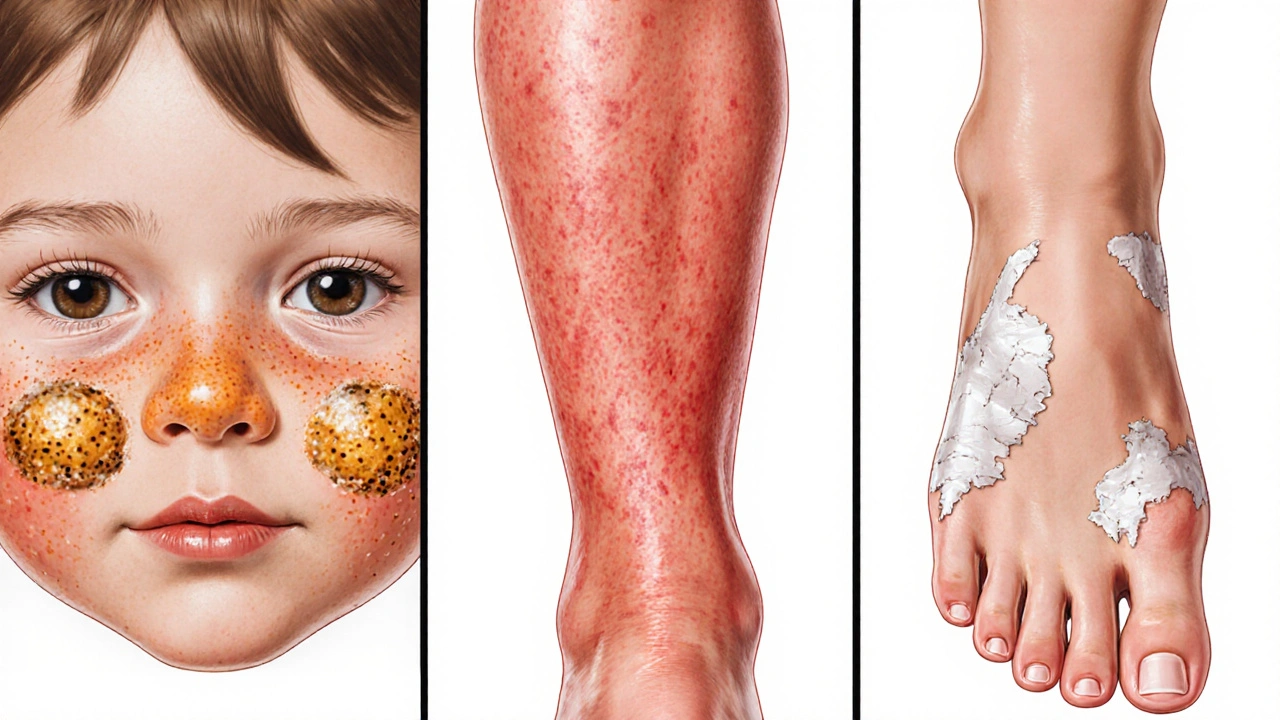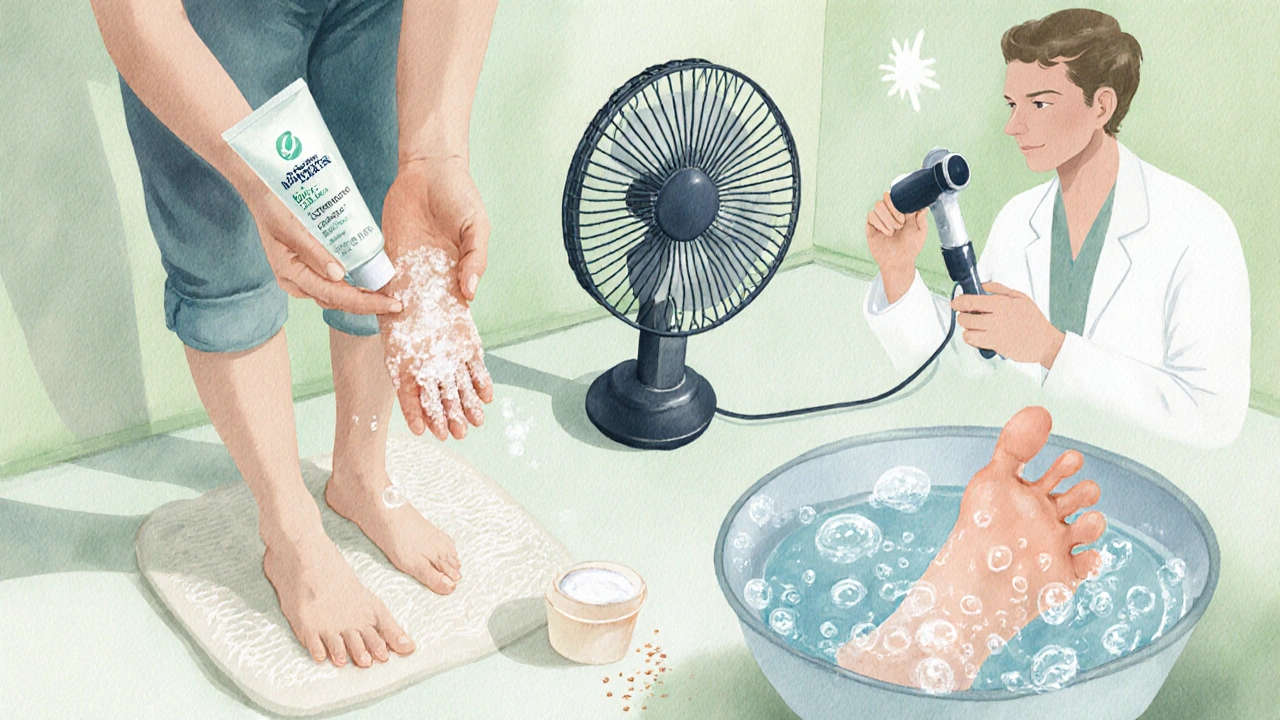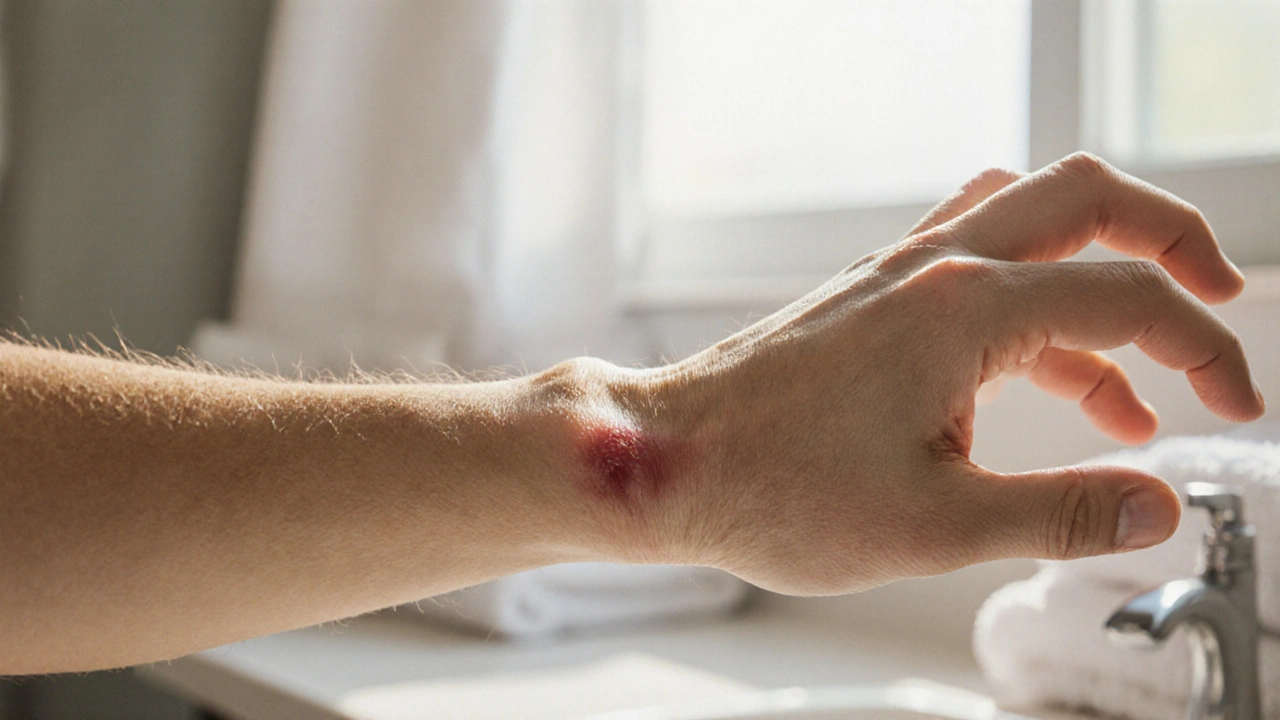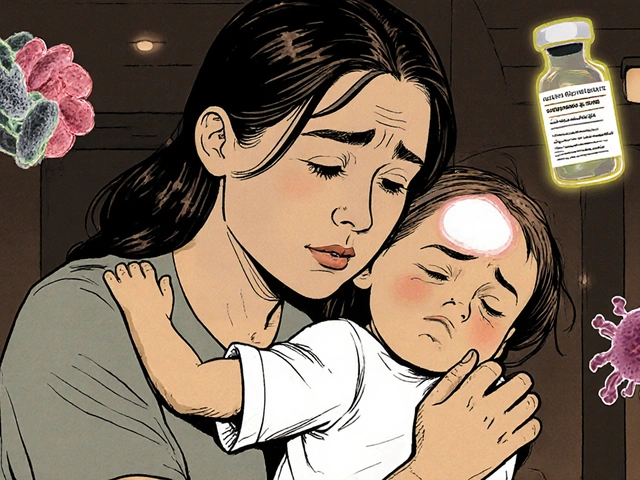Key Takeaways
- Itching can be an early warning sign of a bacterial, fungal, or viral skin infection.
- Redness, swelling, warmth, and discharge are common clues that the itch is more than a simple irritation.
- Specific infections-like impetigo, cellulitis, athlete’s foot, and scabies-have distinct patterns you can recognize.
- Self‑care works for mild cases, but rapid medical attention is needed when pain, fever, or spreading redness appear.
- Good hygiene, moisturisation, and avoiding known irritants cut the risk of future outbreaks.
When an itch turns into a burning, painful patch, most of us wonder whether it’s just dry skin or something more serious. This guide walks you through the most common skin infections that start with an itch, the signs that separate a harmless flare‑up from a genuine infection, and what to do next. Skin infection is any condition where harmful microorganisms invade the outer layers of the body, causing inflammation, irritation, and often visible changes such as redness, swelling, or pus.
Why Itching Often Leads to an Infection
Itching-known medically as pruritus-is the skin’s alarm system. A tiny irritant, an allergic reaction, or a break in the skin’s barrier can trigger nerve endings that send a signal to the brain. While scratching feels good in the moment, it can also open up micro‑tears that let bacteria, fungi, or viruses slip underneath the protective stratum corneum.
Most of the time, a quick rub of a moisturizer or a short‑term anti‑itch cream stops the problem. But when the irritation persists, worsens, or spreads, it’s a clue that an infection has taken hold.
Common Types of Skin Infections and Their Signature Signs
Understanding the three main families of skin infections helps you narrow down what’s happening under the skin.
- Bacterial infection - usually starts as a red, painful spot that may develop yellowish crusts or pus. Common culprits include Staphylococcus aureus and Streptococcus pyogenes.
- Fungal infection - thrives in warm, moist areas. It often shows up as a scaly, circular rash with raised edges and a clearer centre. Dermatophytes such as Trichophyton cause athlete’s foot and ringworm.
- Viral infection - typically produces grouped vesicles that may burst, crust over, or form a rash that follows a nerve path. Herpes simplex and varicella‑zoster (shingles) are classic examples.
Spotlight on Specific Infections
Below are the most frequent skin infections that start with an itch, along with the tell‑tale signs you can look for.
Impetigo
Impetigo is a highly contagious bacterial infection, often caused by S. aureus. It begins as small red bumps that ooze clear fluid, then form honey‑coloured crusts. Children get it most often, but adults with compromised skin (e.g., eczema) are also vulnerable.- Itchy, red lesions that quickly develop a shiny, yellow‑brown crust.
- Usually appears on the face, arms, or legs.
- Can spread to other body parts through scratching or touching.
Cellulitis
Cellulitis is a deeper bacterial infection of the skin and underlying tissue. It often follows a cut, insect bite, or fungal infection.- Rapidly spreading redness, warmth, and swelling that feels tight.
- Painful to the touch; the area may feel hot.
- Fever or chills can accompany the skin changes.
Athlete’s Foot (Tinea Pedis)
This fungal infection loves the damp spaces between toes. It starts with an itchy, burning sensation, then progresses to peeling skin and sometimes a foul smell.
- Itching between the toes, often worse after sweating.
- White or macerated skin that can crack and bleed.
- Can spread to the soles or toenails if untreated.
Scabies
Scabies is caused by the tiny mite Sarcoptes scabiei. The mites burrow into the upper skin layer, leaving a trail of intense itching, especially at night.- Thin, serpentine burrows visible as tiny greyish lines.
- Itching most severe on wrists, elbows, waistline, and between fingers.
- Often spreads through close skin‑to‑skin contact.

Red‑Flag Symptoms: When an Itch Means You Need a Doctor ASAP
Most itching can be handled at home, but these warning signs suggest a more serious infection:
- Sudden, intense pain that doesn’t improve with OTC creams.
- Rapidly expanding redness (especially if the borders are raised and the centre looks soft).
- Fever over 38°C (100.4°F) or chills.
- Presence of pus, blisters that burst, or a foul odor.
- Swelling that interferes with movement of a joint or limb.
If any of these appear, schedule a medical visit within 24hours.
How Doctors Diagnose an Itchy Skin Infection
Diagnosis often starts with a visual exam, but doctors may use additional tools to pinpoint the cause.
- Skin swab or culture: A sample of fluid or crust is taken and grown in a lab to identify bacteria or fungi.
- Scraping for microscopy: Especially useful for scabies, where the mite, eggs, or feces are examined under a microscope.
- Rapid antigen tests: For viral infections like herpes, a quick swipe can reveal viral proteins.
- Blood tests: In severe cellulitis, blood work checks for systemic infection markers.
Self‑Care Steps You Can Take Right Now
- Clean the area: Gently wash with mild soap and lukewarm water. Pat dry-do not rub.
- Apply an appropriate OTC product:
- For bacterial skin infections, a bacitracin or mupirocin ointment can help early on.
- For fungal infections, an over‑the‑counter clotrimazole or terbinafine cream works best.
- For itching without clear infection, a 1% hydrocortisone cream can reduce inflammation.
- Avoid scratching: Use cool compresses or an anti‑itch lotion to curb the urge.
- Cover if contagious: Keep the area loosely covered with a breathable bandage to prevent spreading (especially for impetigo).
- Monitor daily: Note any changes in size, colour, or pain level. If it worsens after 48hours, seek professional care.

When to Seek Professional Help
The safest rule of thumb is: if the itch is accompanied by any red‑flag symptom listed above, or if the rash doesn’t improve after a couple of days of proper self‑care, book an appointment. Early treatment shortens recovery and reduces the chance of complications like scarring or systemic spread.
Prevention: Keep Itching and Infections at Bay
- Stay dry: Change out of sweaty clothes, especially after exercise. Use foot powder for athlete’s foot‑prone areas.
- Moisturise wisely: Apply fragrance‑free creams after bathing to keep skin barrier intact.
- Practice good hygiene: Regular hand‑washing, showering after sports, and not sharing towels or razors.
- Avoid known irritants: Certain fabrics, harsh detergents, or pets that cause allergic reactions.
- Check skin regularly: Early detection of a new spot can mean a quicker, simpler treatment.
Comparison of Bacterial, Fungal, and Viral Skin Infections
| Type | Common Organisms | Typical Signs | Usual Locations | First‑line Treatment |
|---|---|---|---|---|
| Bacterial | Staphylococcus aureus, Streptococcus pyogenes | Redness, warmth, swelling, pus or crust | Face, legs, any broken skin | Topical antibiotics; oral antibiotics if deep |
| Fungal | Trichophyton, Candida, Microsporum | Scaly, circular rash, itching, sometimes odor | Feet, groin, scalp, nails | Topical antifungals; oral for widespread |
| Viral | Herpes simplex, Varicella‑zoster | Grouped vesicles, burning, may crust | Lips, genitals, dermatomal bands | Antiviral pills or creams; early treatment best |
Frequently Asked Questions
Can a simple itch turn into a serious infection?
Yes. If scratching breaks the skin barrier, bacteria, fungi, or viruses can enter and cause an infection. Watch for redness, swelling, pus, or fever as warning signs.
How long does it take for impetigo to clear up with treatment?
With appropriate topical antibiotics, most cases improve within 2‑3 days and clear up fully in about a week. Oral antibiotics may be needed for extensive spread.
Is athlete’s foot contagious?
Yes. The fungus spreads through direct contact or shared surfaces like gym floors, showers, and socks. Keep feet dry and treat early to avoid spreading.
When should I see a doctor for a skin rash?
If the rash is painful, rapidly expanding, accompanied by fever, or shows pus, get medical care within 24hours. Also seek help if you have diabetes or a weakened immune system.
Can over‑the‑counter creams cure a viral skin infection?
OTC creams may relieve itching, but they won’t stop a virus from replicating. Antiviral prescription medication is needed for conditions like herpes or shingles.
Itching is uncomfortable, but it’s also a useful signal that something might be wrong under the surface. By knowing the key signs of bacterial, fungal, and viral skin infections, you can act fast, keep the itch from turning into a full‑blown infection, and get back to feeling normal.





Brandi Thompson
It is astonishing how many people dismiss a simple itch as something trivial when in reality it is a symptom of systemic negligence and poor hygiene habits that plague modern society. The article fails to address the socioeconomic factors that drive people to ignore early signs of infection because they cannot afford proper skin care products. This oversight reveals a deeper bias towards a privileged audience that assumes access to moisturizers and doctor visits is universal. Moreover the language used is overly simplistic and does not educate readers on the microbiological mechanisms that underlie bacterial colonisation of compromised skin. When you consider that Staphylococcus aureus can develop resistance to common antibiotics, the superficial advice given becomes not just inadequate but potentially dangerous. The lack of emphasis on proper wound debridement demonstrates a disregard for evidence based protocols taught in dermatology textbooks. Readers are left with a false sense of confidence that a generic over‑the‑counter ointment will suffice in the face of a potentially invasive cellulitis. The article also omits discussion of the role of immune dysregulation in chronic pruritus, which is a critical omission for anyone with underlying conditions. By glossing over the importance of seeking professional evaluation for persistent redness and swelling, the piece implicitly encourages self‑diagnosis, a practice that has led to countless complications in the past. Furthermore the recommendation to use hydrocortisone without warning about its immunosuppressive effects can exacerbate fungal infections, a fact that should not be ignored. The emphasis on quick fixes over preventive strategies like barrier repair cream application reflects a short‑term mindset that undermines long‑term skin health. It would have been prudent to include a section on the impact of environmental pollutants on skin barrier integrity, a topic that is increasingly relevant. The article also fails to mention the rising incidence of methicillin‑resistant Staphylococcus aureus in community settings, a critical public health concern. Readers seeking thorough guidance are left navigating a maze of incomplete information that could have been avoided with a more comprehensive approach. In summary the piece provides a cursory overview that does not do justice to the complexity of skin infections and their management, and this oversight is both irresponsible and indicative of a broader lack of depth in the content presented.
Chip Hutchison
Hey there, I hear where you’re coming from and I appreciate the thoroughness you bring to the conversation. It’s true that access to care can be a barrier, and many folks do need more guidance on when to see a professional. A balanced approach that includes practical home care while acknowledging those systemic challenges can really empower readers. Maybe adding resources for low‑cost clinics or tele‑dermatology options would bridge that gap. Thanks for highlighting the nuance – it’s important we keep the dialogue open and inclusive.
Emily Moody
Let’s get one thing straight – the average American knows that a simple itch can turn into a full‑blown battlefield of bacterial insurgents if you don’t arm yourself with proper defense. This isn’t some exotic foreign affliction; it’s a home‑grown threat that thrives on complacency and over‑reliance on weak OTC potions. You need to deploy a high‑impact regimen-think broad‑spectrum bacitracin, aggressive antifungal agents, and a regimented hygiene protocol that would make a drill sergeant proud. The microbial adversaries are not just “bugs”; they’re stealthy operatives employing biofilm tactics and antibiotic evasion strategies that could cripple even the toughest skin barrier. Ignoring the red‑flag signals is tantamount to surrendering a strategic position on the front lines of personal health. So, gear up, lock down those dressings, and show those pathogens who’s boss before they claim victory on your epidermis.
Prateek Kohli
Hey Emily, you’ve got some solid points about being proactive 💪. It’s true that early intervention can prevent a nasty escalation. A calm, methodical routine-like cleaning the area, applying the right ointment, and keeping it dry-usually does the trick. Let’s also remember that stress and diet can influence skin health, so a holistic approach helps keep those microbes at bay 🙂. Thanks for the energetic push!
Noah Seidman
From a moral perspective, neglecting the early signs of a skin infection is a dereliction of personal responsibility that reverberates through the community. One could argue that the very act of applying a proper antiseptic regimen reflects a commitment to the social contract of health stewardship. Philosophically, the skin serves as the boundary between self and other; when that boundary is compromised, the individual not only endangers themselves but also becomes a conduit for contagion. Thus, the ethical imperative is clear: proactive care is not merely self‑preservation, but a civic duty. In the grand tapestry of human interaction, each small act of hygiene weaves a stronger fabric of public safety.
Anastasia Petryankina
Oh wow, never thought a rash could be a lesson in civic virtue-how enlightening. I’m sure the ancient Greeks were thrilled to hear about moisturizers and antibiotics. Guess we’ll all start marching in line with our antiseptic cream now.
Tim Ferguson
Look, if the spot is red and hurts, just see a doctor. Over‑the‑counter stuff only works on mild things. Don’t wait too long.
Noah Cokelaere
Yeah, because everyone has a doctor on speed‑dial, right? 🙄 But seriously, a quick visit can save you a lot of trouble.
Brian Jones
Great point, Tim!; however, remember that early detection is key;! Maintaining proper skin hygiene and not ignoring subtle changes can prevent complications!; If you’re unsure, consult a healthcare professional;! Keep your routine consistent and stay informed!;!
Carlise Pretorius
yeah that sounds good i think its important to watch it out and not let it get worse but sometimes i forget to check my skin
Johnson Elijah
Absolutely! 🎉 Keeping skin clean and dry is the first line of defence 🛡️. Don’t let a little itch turn into a major issue – moisturise, protect, and act fast! 👍
Roxanne Lemire
i get that its important but sometimes i just forget to apply cream especially when im busy
Narayan Iyer
Yo fam, let’s talk dermal defense strategy – think of your skin like a fortress, you need the right arsenal: broad‑spectrum antibiotics for bacterial sieges, antifungal powders for fungal infiltrations, and antiviral creams when viral ninjas try to breach the walls. The key is to spot the red‑flag signals early – like rapid spreading erythema, warmth, and pain – and deploy the proper counter‑measures before the infection gains momentum. Also, don’t forget the importance of barrier reinforcement – a good barrier cream can stop those micro‑tears from becoming entry points for pathogens. Stay sharp, keep it clean, and your skin will stay winning!
Gary Smith
Exactly!!! We gotta protect our bodies like we protect our nation!!! No compromise on hygiene, no compromise on health!!! Let’s gear up with the best meds and keep those invaders out!!!
Matthew Holmes
What the articles don’t tell you is that the push for over‑the‑counter creams is a smokescreen created by big pharma to keep you dependent on their products while they hide the real cure in plain sight. The truth is out there, buried under layers of corporate propaganda, and if you look closely you’ll see the pattern of suppression that keeps us guessing about simple, natural remedies that could stop infections before they start. Stay vigilant, question the sources, and don’t let the mainstream narrative dictate your health decisions.
Patrick Price
Yo, you really need to stop scratching that damn spot.